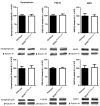Changes in 5-HT2A-mediated behavior and 5-HT2A- and 5-HT1A receptor binding and expression in conditional brain-derived neurotrophic factor knock-out mice
- PMID: 20576498
- PMCID: PMC2914121
- DOI: 10.1016/j.neuroscience.2010.05.054
Changes in 5-HT2A-mediated behavior and 5-HT2A- and 5-HT1A receptor binding and expression in conditional brain-derived neurotrophic factor knock-out mice
Abstract
Changes in brain-derived neurotrophic factor (BDNF) expression have been implicated in the etiology of psychiatric disorders. To investigate pathological mechanisms elicited by perturbed BDNF signaling, we examined mutant mice with central depletion of BDNF (BDNF(2L/2LCk-cre)). A severe impairment specific for the serotonin 2A receptor (5-HT(2A)R) in prefrontal cortex was described previously in these mice. This is of much interest, as 5-HT(2A)Rs have been linked to neuropsychiatric disorders and anxiety-related behavior. Here we further characterized the serotonin receptor alterations triggered by BDNF depletion. 5-HT(2A) ([(3)H]-MDL100907) and 5-HT(1A) ([(3)H]-WAY100635) receptor autoradiography revealed site-specific alterations in BDNF mutant mice. They exhibited lower 5-HT(2A) receptor binding in frontal cortex but increased binding in hippocampus. Additionally, 5-HT(1A) receptor binding was decreased in hippocampus of BDNF mutants, but unchanged in frontal cortex. Molecular analysis indicated corresponding changes in 5-HT(2A) and 5-HT(1A) mRNA expression but normal 5-HT(2C) content in these brain regions in BDNF(2L/2LCk-cre) mice. We investigated whether the reduction in frontal 5-HT(2A)R binding was reflected in reduced functional output in two 5-HT(2A)-receptor mediated behavioral tests, the head-twitch response (HTR) and the ear-scratch response (ESR). BDNF(2L/2LCk-cre) mutants treated with the 5-HT(2A) receptor agonist (+/-)-2,5-dimethoxy-4-iodoamphetamine (DOI) showed a clearly diminished ESR but no differences in HTR compared to wildtypes. These findings illustrate the context-dependent effects of deficient BDNF signaling on the 5-HT receptor system and 5-HT(2A)-receptor functional output.
Copyright (c) 2010 IBRO. Published by Elsevier Ltd. All rights reserved.
Figures









References
-
- Akimova E, Lanzenberger R, Kasper S. The serotonin-1A receptor in anxiety disorders. Biol Psychiatry. 2009;66:627–635. - PubMed
-
- Chan JP, Unger TJ, Byrnes J, Rios M. Examination of behavioral deficits triggered by targeting Bdnf in fetal or postnatal brains of mice. Neuroscience. 2006;142:49–58. - PubMed
-
- Cornea-Hebert V, Riad M, Wu C, Singh SK, Descarries L. Cellular and subcellular distribution of the serotonin 5-HT2A receptor in the central nervous system of adult rat. J Comp Neurol. 1999;409:187–209. - PubMed
-
- Darmani NA. Cannabinoids of diverse structure inhibit two DOI-induced 5-HT(2A) receptor-mediated behaviors in mice. Pharmacol Biochem Behav. 2001;68:311–317. - PubMed
-
- Dave KD, Fernando GS, Quinn JL, Harvey JA, Aloyo VJ. Serotonin 5-HT2A receptors in the CA1 field of the hippocampus mediate head movements in the rabbit. Psychopharmacology (Berl) 2004;176:287–295. - PubMed
Publication types
MeSH terms
Substances
Grants and funding
LinkOut - more resources
Full Text Sources
Molecular Biology Databases
Miscellaneous

